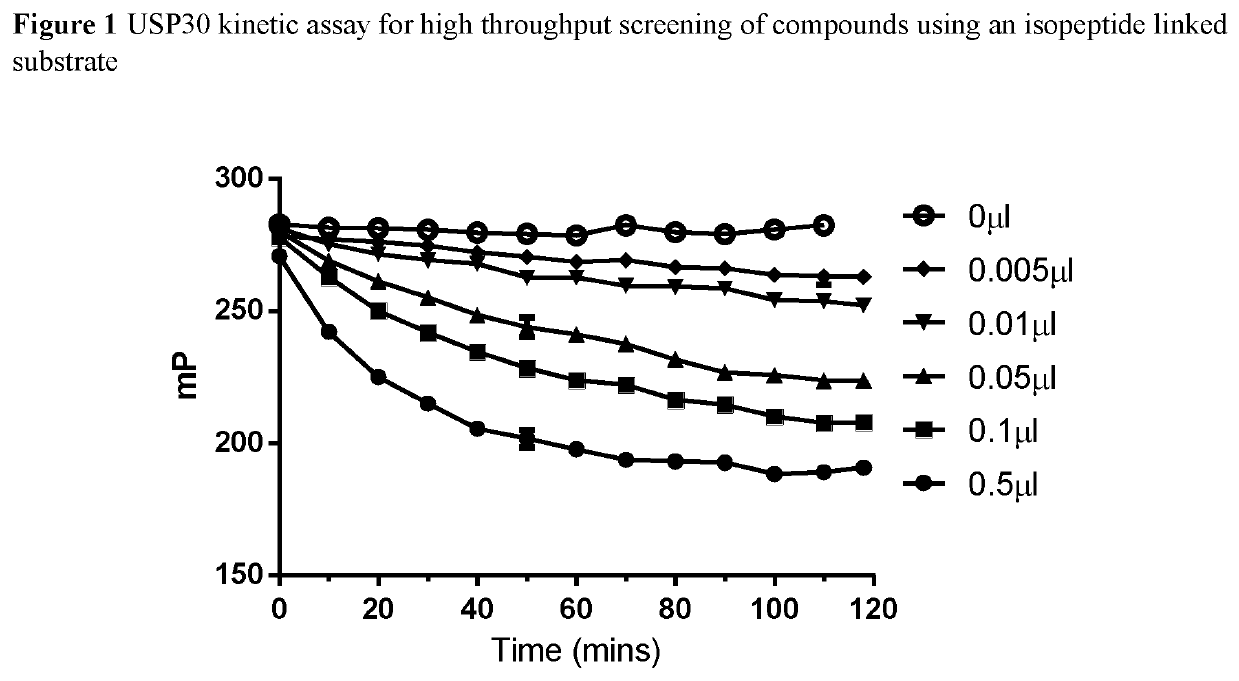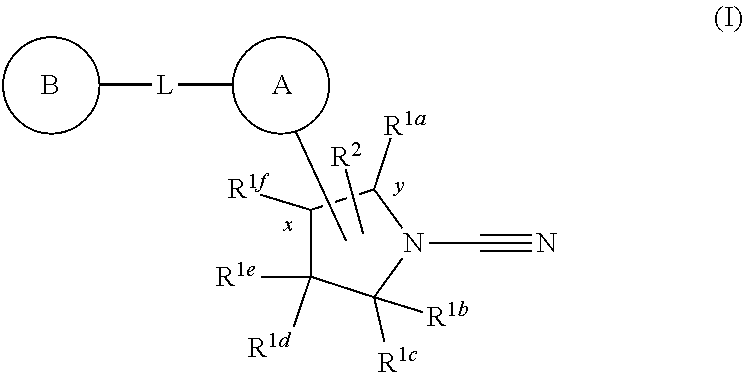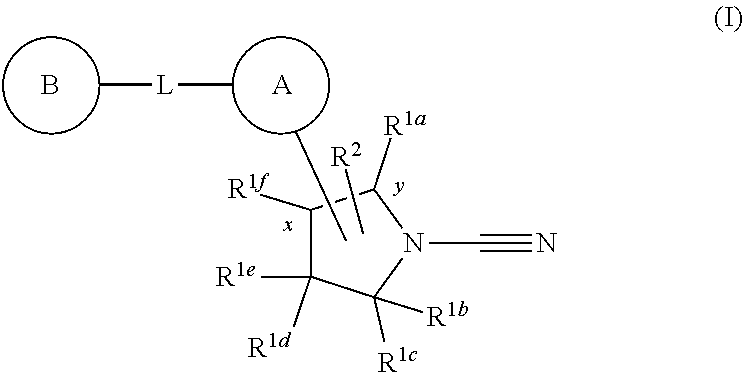1-cyano-pyrrolidine derivatives as dub inhibitors
- Summary
- Abstract
- Description
- Claims
- Application Information
AI Technical Summary
Benefits of technology
Problems solved by technology
Method used
Image
Examples
example 14 3-(
3-([1,1′-Biphenyl]-3-yl)-1H-pyrazol-5-yl)pyrrolidine-1-carbonitrile
[0635]
[0636]Step a. To a suspension of sodium hydride (60% dispersion in mineral oil, 2.1 g, 53.0 mmol) in THF (125 ml) was drop wise added a solution of dimethyl (2-oxopropyl)phosphonate (CAS Number 4202-14-6; 8 g, 48.2 mmol) in THF (125 ml) at 0° C. The reaction mixture was stirred at 0° C. for 1 h. 4-Methylbenzenesulfonyl azide (CAS Number 941-55-9; 10 g, 51.0 mmol) was added to the reaction mixture at 0° C. The reaction mixture was stirred at 0° C. for 1 h. The resulting reaction mixture was filtered through celite hyflow and the resulting filtrate was concentrated under reduced pressure. The resulting residue was purified by flash chromatography (4-5% EtOAc in hexane) yielding dimethyl (1-diazo-2-oxopropyl)phosphonate (6.0 g, 31.2 mmol). LCMS: Method C, 1.234 min, MS: ES+193.09; 1H NMR (400 MHz, CDCl3) δ ppm 3.89 (s, 3H), 3.85 (s, 3H), 2.29 (s, 3H).
[0637]Step b. To a solution of 3-formyl-pyrrolidine-1-carboxylic...
example 15 3-(
3-([1,1′-Biphenyl]-3-yl)-4-fluoro-1H-pyrazol-5-yl)pyrrolidine-1-carbonitrile
[0641]
[0642]Step a. A solution of tert-butyl 3-(3-([1,1′-biphenyl]-3-yl)-1H-pyrazol-5-yl)pyrrolidine-1-carboxylate (Example 14, step c) (0.26 g, 0.67 mmol) and 1-chloromethyl-4-fluoro-1,4-diazoniabicyclo[2.2.2]octane bis(tetrafluoroborate) (CAS Number 140681-55-6; 0.24 g, 0.67 mmol) in MeCN (5 ml) was heated in microwave at 90° C. for 1 h. The resulting reaction mixture was cooled to rt and concentrated under reduced pressure yielding 3-([1,1′-biphenyl]-3-yl)-4-fluoro-5-(pyrrolidin-3-yl)-1H-pyrazole (0.49 g, quantitative). LCMS: Method C, 1.945 min, MS: ES+308.23. This material was used for the next step without further purification.
[0643]Step b. The title compound was synthesised from the intermediate above using a procedure similar to that described for Example 14, step e. LCMS: Method A, 4.944 min, MS: ES+333.14; 1H NMR (400 MHz, DMSO-d6, 80° C.) 5 ppm 12.81-13.11 (m, 1H), 7.98 (s, 1H), 7.49-7.73 (m, 7H),...
example 16 3-(
3-([1,1′-Biphenyl]-3-yl)-4-fluoro-1H-pyrazol-5-yl)pyrrolidine-1-carbonitrile: Enantiomer 1
[0645]LCMS: Method A, 5.028 min, MS: ES+333.08; Chiral SEC: CHIRALPAK IF 250×4.6 mm 5 μm, mobile phase: (A) Liquid carbon dioxide; (B) MeOH, column flow was 4.0 ml / min and ABPR was 150 bar, isocratic gradient of 50% B over 12 min, RT 7.7 min; 1H NMR (400 MHz, DMSO-d6) δ ppm 12.86-13.20 (m, 1H), 7.98 (s, 1H), 7.66-7.72 (m, 4H), 7.57-7.60 (m, 1H), 7.49-7.53 (m, 2H), 7.41-7.43 (m, 1H), 3.76-3.80 (m, 1H), 3.49-3.61 (m, 4H), 2.28-2.33 (m, 1H), 2.08-2.13 (m, 1H).
PUM
 Login to View More
Login to View More Abstract
Description
Claims
Application Information
 Login to View More
Login to View More - R&D
- Intellectual Property
- Life Sciences
- Materials
- Tech Scout
- Unparalleled Data Quality
- Higher Quality Content
- 60% Fewer Hallucinations
Browse by: Latest US Patents, China's latest patents, Technical Efficacy Thesaurus, Application Domain, Technology Topic, Popular Technical Reports.
© 2025 PatSnap. All rights reserved.Legal|Privacy policy|Modern Slavery Act Transparency Statement|Sitemap|About US| Contact US: help@patsnap.com



